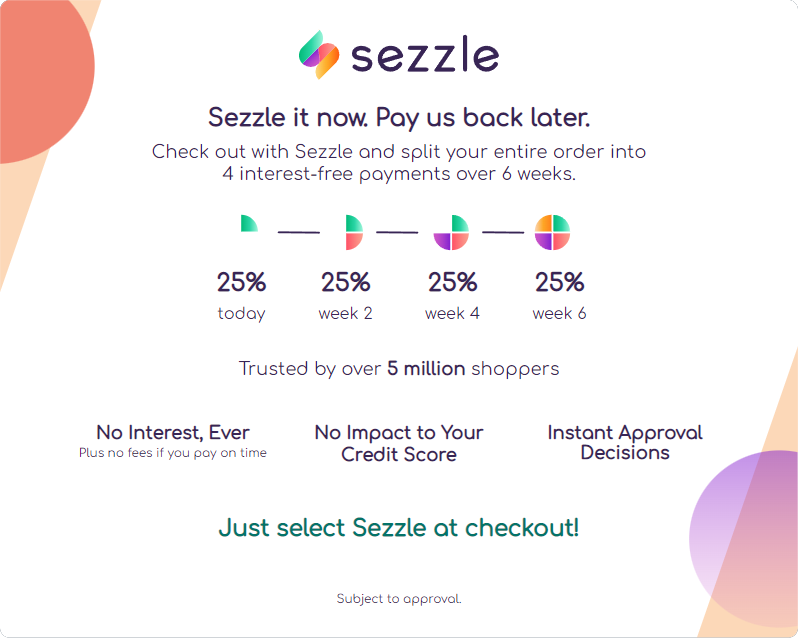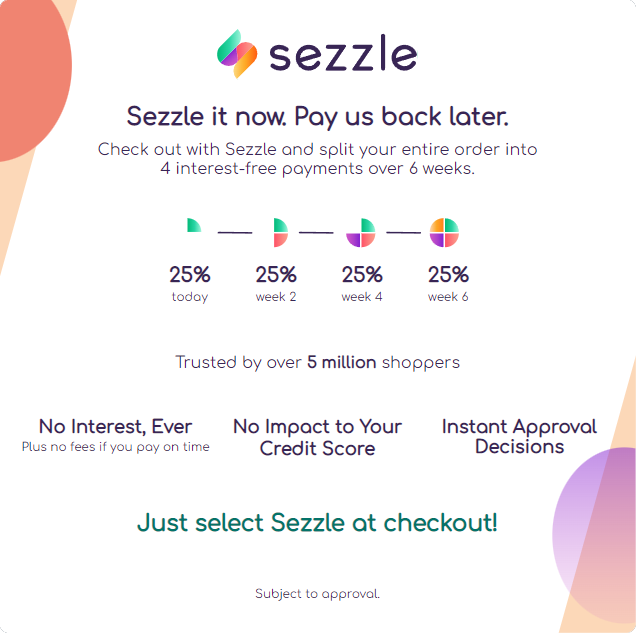



We provide a 24-month warranty on all of our products.

We take immense pride in our products and know you're going to love them as much as we do. If you're not 10/10 obsessed, let us know within 30 days for our 100% money back guarantee.

 ✕
✕
Check out with Sezzle and split your entire order into 4 interest-free payments over 6 weeks.
On all orders $90USD+ we offer free 2-7 business day standard shipping in the US + CA and 11-20 business day shipping in the UK.
Unfortunately we are unable to make deliveries to PO boxes, APO/FPO, or US military bases outside the US.

 Taylor LED Compact Mirror
Taylor LED Compact Mirror
 Vera Vanity with 10x Lara Mirror
Vera Vanity with 10x Lara Mirror
 Rivo Nano Ionic Facial Steamer
Rivo Nano Ionic Facial Steamer
 Abigail LED Travel Mirror
Abigail LED Travel Mirror
 Mini Taylor LED Compact Mirror
Mini Taylor LED Compact Mirror
 Ultimate Mirror Bundle
Ultimate Mirror Bundle
 Abigail Travel Mirror with 10x Magnification
Abigail Travel Mirror with 10x Magnification
 Mila 2 Luxe LED Compact Mirror
Mila 2 Luxe LED Compact Mirror
 Tru-Glow Lighted Mirrors Duo
Tru-Glow Lighted Mirrors Duo
 Clara Microdermabrasion Device
Clara Microdermabrasion Device
 Jingle and Glow Kit
Jingle and Glow Kit
 Cali Electric Callus Remover
Cali Electric Callus Remover
 Isla Facial Cleansing Brush
Isla Facial Cleansing Brush
 Madison Makeup Case
Madison Makeup Case
 The Glow Getter Ritual Set
The Glow Getter Ritual Set
 Mila 2 LED Compact Mirror
Mila 2 LED Compact Mirror
 Madeline Mini Hollywood Mirror
Madeline Mini Hollywood Mirror
 Mini Taylor LED Compact Mirror | Romantic Florals
Mini Taylor LED Compact Mirror | Romantic Florals
 Vera Lighted Vanity Mirror
Vera Lighted Vanity Mirror
 Lana 10x Magnifying Mirror
Lana 10x Magnifying Mirror
 Juni 2 Lighted Car Visor Mirror
Juni 2 Lighted Car Visor Mirror
 Taylor LED Compact Mirror | Cheetah Chic
Taylor LED Compact Mirror | Cheetah Chic
 Mini Taylor LED Compact Mirror | Cosmic Leopard
Mini Taylor LED Compact Mirror | Cosmic Leopard
 Soft & Smooth Body Kit
Soft & Smooth Body Kit
 Cami Lighted Handheld Mirror
Cami Lighted Handheld Mirror
 Pore-Parazzi Set
Pore-Parazzi Set
 2 Be Lit Mirror Duo
2 Be Lit Mirror Duo
 Aria Pro Makeup Brush Set
Aria Pro Makeup Brush Set
 Love at First Light Mirror Set
Love at First Light Mirror Set
 Daily Essentials Skincare Kit
Daily Essentials Skincare Kit
 Taylor LED Compact Mirror | Blush Zebra
Taylor LED Compact Mirror | Blush Zebra
 Glowing Places Kit
Glowing Places Kit
 Mini Taylor LED Compact Mirror | Cheetah Chic
Mini Taylor LED Compact Mirror | Cheetah Chic
 Mini Taylor LED Compact Mirror | Blush Zebra
Mini Taylor LED Compact Mirror | Blush Zebra
 Monroe Hollywood Vanity Mirror
Monroe Hollywood Vanity Mirror
 Mira 2 Magnifying Mirror 10x
Mira 2 Magnifying Mirror 10x
 Farah Makeup Remover Set
Farah Makeup Remover Set
 Torri Face and Body Trimmer Set
Torri Face and Body Trimmer Set
 Remi Uplift Facial Massage Roller
Remi Uplift Facial Massage Roller
 Macy Makeup Bag
Macy Makeup Bag
 Avery Spa Headband Set
Avery Spa Headband Set
 Harper Makeup Sponge Set
Harper Makeup Sponge Set
 Tara 10x Magnifying Mirror
Tara 10x Magnifying Mirror
 Leather Pouch for Mila 2 Mirror
Leather Pouch for Mila 2 Mirror
 Zoe Eye Cleansing Pad
Zoe Eye Cleansing Pad
 Charlotte Scalp Massager
Charlotte Scalp Massager
 Lara 10x Magnifying Mirror for Vera
Lara 10x Magnifying Mirror for Vera
 Zoe Drying Pads
Zoe Drying Pads
 Traveling Twosome
Traveling Twosome
 Tala Gooseneck Attachment for Mira
Tala Gooseneck Attachment for Mira
![Gift Card [USD]](http://fancii.com/cdn/shop/products/fancii-gift-card_45x.gif?v=1762198925) Gift Card [USD]
Gift Card [USD]
![Gift Card [CAD]](http://fancii.com/cdn/shop/products/fancii-gift-card_8caf3995-16f8-44ab-90b2-3aa4b3050424_45x.gif?v=1762269131) Gift Card [CAD]
Gift Card [CAD]
![Gift Card [GBP]](http://fancii.com/cdn/shop/products/fancii-gift-card_bda6bc27-1ef2-4efb-bf94-e3f8882f7d97_45x.gif?v=1762269131) Gift Card [GBP]
Gift Card [GBP]
 Cora 3 Facial Cleansing Brush
Cora 3 Facial Cleansing Brush
 Elle Satin Scrunchie
Elle Satin Scrunchie
 Audrey Satin Headband 3 Pack
Audrey Satin Headband 3 Pack
 Zoe Cleanse
Zoe Cleanse
 Elle - 3 PK
Elle - 3 PK
 Audrey Satin Headband
Audrey Satin Headband
 Mini Taylor LED Compact Mirror | Meadow
Mini Taylor LED Compact Mirror | Meadow
 Mini Taylor LED Compact Mirror | Mediterranean Coast
Mini Taylor LED Compact Mirror | Mediterranean Coast
 Glowcation Station
Glowcation Station
 Taylor LED Compact Mirror | Cosmic Leopard
Taylor LED Compact Mirror | Cosmic Leopard
With a wide range of styles and features to choose from, finding the right magnifying glass for your needs may seem a rather daunting task. But instead of exploring every option on the market, think of finding the right magnifier as shopping for your next pair of shoes: you want comfort and the best style, but above all you want the right fit.
To help with your selection, consider these two simple steps:
First and foremost, you should decide what purpose your magnifying glass is going to serve. It’s far better to let the project determine the magnifier required, than to try and turn a single magnifying glass into a one-size-fits-all tool:
Do you need to enlarge the print of your book, newspaper, or crossword puzzle?
Consider a handheld reading magnifier.
Do you want to take your magnifier to the restaurant or grocery store for deciphering menus and labels?
A keychain or pocket-size magnifier might work best for you.
Do you need to magnify a hobby that requires the use of your hands or other tools, such as knitting or model-building?
One of the many hands-free options is probably your best bet.
Does your project involve studying the fine details of a gem, stamp, or document?
A jeweler’s loupe is ideal for this type of work.
Honing in on your personal needs will let you eliminate certain categories of magnifying glasses from your search right away.
A number of components contribute to the performance of your magnifying glass, but for the average user, there are three main features you should consider:
Magnification, or Power
Focal Length, or Working Distance
Field of View
It may sound strange, but the magnifier with the highest power isn’t always the best choice. The human eye has an optimal viewing distance: the closer we hold an object to our eyes, the more of its detail we can theoretically see, but it will be out of focus. That’s where the magnifying glass comes in. A magnifier with a 2X power, for example, enlarges an object and lets us see it as though it were two times closer to our eyes, but the object remains in focus. Does that mean that a magnifier offering 20X power is ten times more useful than our 2X magnifier? Not necessarily. There are limits to the practicality of a high-powered magnifying glass, because of the way that magnification, focal length and field of view work together.
The focal length of a magnifier is the distance from its lens to the object being viewed, when the object is in focus. The power and focal length of a magnifying glass are actually inversely related. In other words, the higher the magnification, the shorter a magnifier’s working distance is, and vice versa. Having sufficient room to manoeuver beneath the lens is an important consideration when your hobby or project requires the use of tools, and it’s one of the reasons why a higher magnification isn’t always the better choice.
The field of view refers to the size of the area that’s in focus when viewed through a magnifier’s lens. In much the same way that focal length is inversely related to magnification, so too is the field of view. The higher the power of a magnifying glass, the smaller its field of view will be. That means you’ll be able to see more detail with a higher magnification, but only across a relatively small area. Generally speaking, a 2-3X magnifier offering a larger field of view is better for scanning activities like reading, while the smaller field associated with a higher magnification would be more appropriate for the inspection of fine detail.
Once you’ve determined the style and technical features that best suit your needs, you may also want to consider some of these important magnifying glass properties:
lens quality (distortion, color clarity, scratch-resistance)
weight, comfort, and ease of use
durability of frame or handle
incorporation of a light source
Although the perfect lightweight magnifier, combining a clear, high magnification with a wide viewing area is an optical impossibility, finding the perfect magnifying glass for your personal needs is not only possible, it’s a definite reality.
Customer CommentsI’m 87yrs old & need a Magnifying Glass on a stand so I can do some sewing underneath
the glass, therefore needing my hands free! I think I need 2×3 strength? Await your reply! Thank-you. Hazel Vane
Very helpful article. Thank you!
On March 08, 2023My 94yr old mother has requested a magnifying glass so she can see fine print when reading and do her daily crosswords. She’s an avid reader but even with her script glasses on finds the print hard to see. She currently also only has use of one arm
On March 08, 2023I need any help you can give me
On March 08, 2023